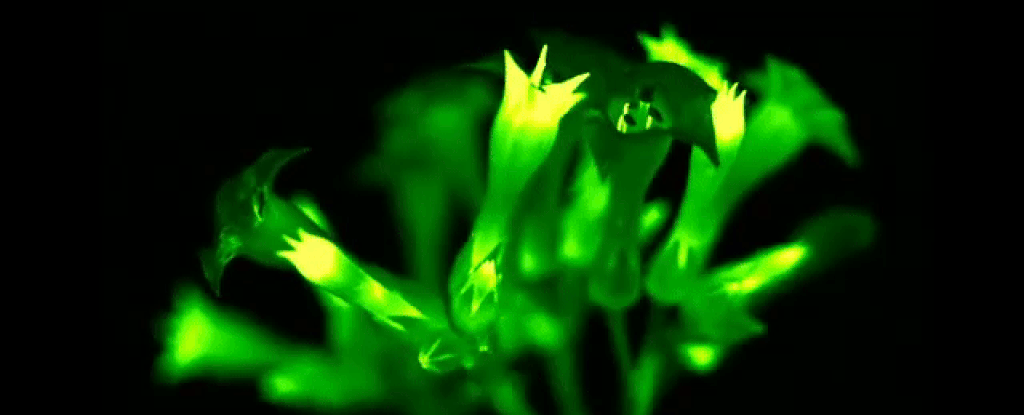
The glowing greenhouse of our dreams is still so very far away, but it just got a tantalising nudge closer.
Scientists have genetically engineered a plant with not just a visible glow, but a self-sustaining glow that lasts for the duration of the plant's life cycle.
It's a breathtaking improvement on previous glowing plants. It's brighter than previous genetically engineered tobacco plants, and it doesn't need to be fed with chemicals to maintain luminescence. Also, the duration of the glow is much longer than glowing plants produced using plant nanobionics.
Of course, we all immediately think of a breathtaking Avatar-style night garden, glittering and gleaming in the darkness, and - further into the future - reducing our dependence on electric lighting.
But glowing greenery could also help us understand the plants themselves - how their metabolism works, and how they respond to the world around them.
The team worked on two species of tobacco plant. And, unlike previous genetically engineered glowing plants, which used bioluminescent bacteria or firefly DNA, these plants were engineered using the DNA of bioluminescent fungi.
"Although bacterial bioluminescence genes can be targeted to plastids to engineer autoluminescence, it is technically cumbersome and fails to produce sufficient light," the researchers wrote in their paper.
"The caffeic acid cycle, which is a metabolic pathway responsible for luminescence in fungi, was recently characterised. We report light emission in Nicotiana tabacum and Nicotiana benthamiana plants without the addition of any exogenous substrate by engineering fungal bioluminescence genes into the plant nuclear genome."
It was only at the end of 2018 that a team of researchers (many of whom worked on this new research also) published a paper on the biosynthesis of fungal luciferin, the compounds that produce a glow in luminescent fungi.
They discovered that these fungi synthesise luciferin from a compound called caffeic acid, worked upon by four enzymes. Two enzymes work to transform caffeic acid into a luminescent precursor; a third enzyme oxidises this precursor to produce a photon. The fourth enzyme then converts the molecule back to caffeic acid, which can be recycled through the same process.
And this is where things get interesting - because caffeic acid (no relation to caffeine) is found in all plants. It's key to the biosynthesis of lignin, the wood polymer that gives plant cell walls rigidity and strength.
The team reasoned that it might, therefore, be possible to genetically engineer plants to reallocate some of their caffeic acid to the biosynthesis of luciferin, as seen in bioluminescent fungi.
They spliced their tobacco plants with four fungus genes associated with bioluminescence, and carefully cultivated them. And they found that the plants glowed with a light visible to the naked eye from seedling to maturity - without any apparent cost to the health of the plant.
"The overall phenotype, chlorophyll and carotenoid content, flowering time and seed germination did not differ from wild-type tobacco in the greenhouse, with the exception of a 12 percent increase in median height of transgenic plants," the researchers wrote in their paper.
"This suggests that, unlike expression of bacterial bioluminescence, expression of caffeic acid cycle is not toxic in plants and does not impose an obvious burden on plant growth, at least in the greenhouse."
They found that younger parts of the plant glowed most brightly, with the flowers growing brightest of all. These produced, the researchers said, around a billion photons per minute. That's not nearly enough to read by, but it is bright enough to be clearly visible.
It's also around 10 times brighter than other genetically engineered glowing plants, the researchers said. It's not quite the brightest plant produced; that honour belongs to watercress produced by scientists at MIT using a technique called plant nanobionics, which produced a glow of around a trillion photons per second… but it only lasted 3.5 hours.
This new long-term, self-sustaining glow, the team found, could act as an indicator for how the plants responded to their external environment. When they placed a banana skin nearby, for instance, the plants would glow more brightly in response to the ethylene emitted.
The also observed flickering and waves in the light, produced by internal metabolic processes that are usually hidden - suggesting that this research could be an interesting way to study plant health.
"By enabling autonomous light emission, dynamic processes in plants can be monitored, including development and pathogenesis, responses to environmental conditions and effects of chemical treatment," the researchers wrote in their paper.
"By removing the need for exogenous addition of luciferin or other substrates, these luminescent capabilities should be particularly useful for experiments with plants grown in the soil."
Meanwhile, the team is working on expanding the research. They have genetically modified popular flowering plants such as periwinkles, petunias, and roses. They are also trying to produce an even brighter glow, and different colours. And they are thinking much, much bigger.
"Although caffeic acid is not native to animals, autonomous luminescence could also be enabled in animals," they wrote.
Wouldn't that be something.






No comments:
Post a Comment